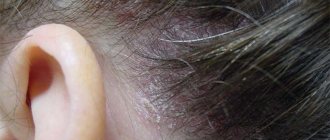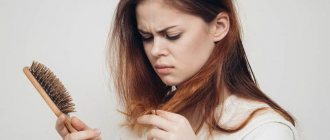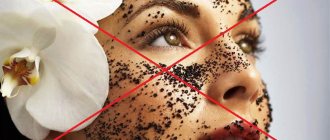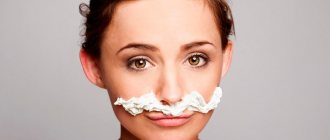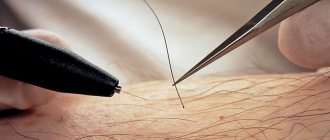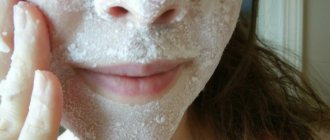Trichology (from the Greek “trichos” - hair, “logos” - science) is the science of hair and scalp, which studies the structure and physiology of hair, develops theoretical and practical methods for treating hair and scalp.
In the West, trichology as a separate scientific direction was formed in the middle of the 20th century. Since then, there has been a qualitative breakthrough in its development: from small scattered schools and individual doctors to large associations, centers and institutes for the study of hair. Trichology appeared in Russia later, in the early 1990s. And like any science, with the accumulation of scientific data, it has now acquired an integrated approach to the treatment of trichological diseases.
Reasons for visiting a trichologist
- increased hair loss,
- loss of hair volume,
- dandruff and itching of the scalp.
Signs of hair loss
- after washing your hair, more than 15 hairs fall out;
- a large amount of hair remains on the comb;
- Separate “islands” appear on the head, devoid of hair;
- there may be partial loss of eyelashes and eyebrows;
- itching and flaking of the scalp.
Hair loss often indicates the presence of certain disorders or diseases in the body. To properly deal with the problem of alopecia (baldness), you need to understand the reasons for its occurrence.
Causes of hair loss
- genetic predisposition;
- exposure to harmful chemicals, radiation - hair loss often occurs after chemotherapy for oncology treatment;
- development of autoimmune diseases;
- diseases of the gastrointestinal tract;
- impaired blood circulation in the scalp and cervical region;
- development of infections, spread of parasites;
- previous operations and injuries;
- poor nutrition or exhausting diets;
- lack of vitamins in the body;
- severe stress, depression;
- long-term use of medications.
The causes of baldness listed above apply to both men and women. However, let's take a closer look at the causes of hair loss in women. Most often, the cause of an unpleasant problem can be changes in a woman’s hormonal levels. Increased hair loss in women often begins a few weeks after giving birth and can last up to several months. This often happens due to increased levels of stress, fatigue, lack of sleep, and decreased protein levels in the body.
During pregnancy itself, hair may also fall out, especially if the expectant mother does not adhere to a balanced diet. Due to nutrient deficiency, baldness occurs, since most of the nutrients and nutrients are spent on maintaining the health of the baby in the womb.
A woman's body over the age of 40 again undergoes hormonal changes as it prepares for menopause. The unstable emotional state of a woman during this period and a decrease in metabolism also affects the condition of the hair follicles, the hair receives insufficient nutrition and weakens.
As for improper hair care: constant use of a hair dryer, curling iron or hair straightener, dyeing with chemicals, etc. only aggravates an existing problem and is unlikely to become the true cause of baldness on its own.
Main features
The symptoms of seborrheic alopecia are similar to those of seborrhea, since both diseases are caused by a malfunction of the sebaceous glands. The main features include:
- unpleasant odor;
- rapid loss of freshness and cleanliness of hair after washing;
- thickened layer of keratinized skin;
- presence of inflammation.
Increased activity of the sebaceous glands leads to the appearance of excess oil on the skin. Sebaceous ducts and hair follicles become clogged. Horny particles accumulate on the scalp, face, and body. They stick together and form a viscous mass. This environment is good for fungal growth. The parasite becomes active, attacks the hair follicles, the hair becomes weak and begins to fall out.
There are three main types of seborrhea: dry, oily and mixed. Alopecia occurs with oily skin.
Message sent!
What is hair loss like?
- Focal or nested - separate “nests” appear on the head, on which the hair initially thins and then falls out completely. The areas of loss have clear contours. Often this type of alopecia can be observed in men. In women, it is accompanied by loss of eyelashes and eyebrows.
- Symptomatic or diffuse – hair falls out evenly over the entire head, and the remaining hairs become thinner and thinner. Baldness in this case is a consequence of a serious chronic disease. The loss resolves after a course of treatment for the underlying disease.
- Androgenic hair loss is a common type of hair loss in men. An irreversible process that leads to complete loss of hair on the head. Baldness begins unexpectedly in the frontal area in men and in the parting area in women. The first signs of androgenic loss are severe thinning of hair and a decrease in its number. If you notice the problem in time and contact a specialist, you can completely stop the alopecia process, but lost hair cannot be returned.
- Seborrheic – often occurs in women. Seborrhea is a condition of the scalp in which excessive sebum secretion occurs. As a result, a stratum corneum forms on the scalp, which is accompanied by scalp itching, flaking and hair loss. The process of loss in this case is reversible; you just need to cure the cause.
- Hereditary – hair loss due to genetic predisposition is often accompanied by brittle nails and tooth dystrophy. This is a common cause of baldness in men, but is extremely rare in women.
- Cicatricial – scars form at the site of severe injury. At this point, hair follicles stop growing for life. Cicatricial baldness can be triggered by previous infectious diseases, burns or injuries.
Characteristic symptoms of seborrhea
Seborrheic dermatitis is characterized by a range of symptoms.
Bold form:
- frizzy, sticky hair;
- greasy shine;
- increased oiliness of facial skin;
- the appearance of redness, ulcers on the face, head and back;
- dandruff;
- seborrheic growths.
Dry form:
- tight, dry skin on which wounds easily form;
- dry hair;
- fragility, weakness of hairs;
- loose dandruff.
In both cases, itching may be present. The patient wants to scratch the skin all the time. Sometimes there is a feeling of soreness on the skin. With severe manifestations, wounds and ulcers that occur when scratching are possible.
Hair loss tests
If you have the first signs of hair loss, start by consulting a trichologist. Using computer diagnostics (trichogram), a specialist will determine the number and diameter of hair, the condition of the skin and sebaceous glands. To determine the cause of alopecia, you may be asked to undergo an examination by other specialists: a gynecologist, an endocrinologist, a neurologist, or a therapist.
The gynecologist will help the woman correct hormonal imbalances. If the cause of hair loss lies in the presence of diseases of the gastrointestinal tract, you should consult a gastroenterologist.
You will be offered to hand over
- detailed blood test,
- blood for biochemistry,
- detailed urine analysis,
- tests for parasites,
- tests for female sex hormones,
- detailed hair analysis for the presence of toxins,
- hair testing to assess mineral status.
As a result, the doctor will be able to determine the extent of the disease and prescribe appropriate treatment.
Causes
Oily seborrhea can appear at any age. However, most often this occurs in adolescence and during hormonal imbalances in the body. Baldness is a consequence of chronic seborrhea, which can last for about five years without any serious consequences.
To begin adequate therapy, it is important to identify and eliminate the root cause of sebaceous gland dysfunction. It could be:
- failure of the endocrine system;
- disorders in the autonomic system;
- long-term drug treatment;
- hormonal disorder;
- hereditary predisposition;
- improper metabolism;
- poor nutrition;
- some diseases and complications of diseases.
Before starting treatment for baldness, it is important to conduct a medical examination to identify possible underlying causes.
Methods for treating hair loss
To treat alopecia, you need to use an integrated approach: massage, medications and vitamin complexes, the use of specialized shampoos and salon procedures. It is important to note that giving up bad habits, a balanced diet and restoring sleep and wakefulness also play a big role in the treatment of hair loss.
Hair loss treatment methods:
- Surgical - Scarring alopecia can be treated with hair follicle transplantation. Many patients cannot afford surgical operations, and for some, operations are not an acceptable solution due to the presence of contraindications.
- Physiotherapy. Medicinal products are applied to the skin and heated using special devices. This is where laser therapy comes into play. The laser stimulates all metabolic processes in the body and hair treatment occurs more actively.
- The injection method improves hair growth, awakens “dormant” hair follicles, eliminates dandruff and fights scalp diseases by injecting a special cocktail into the scalp. The complex of preparations for the procedure contains all the necessary vitamins, microelements, nutrients, beneficial amino acids, etc.
- Therapeutic method is the use of ointments, masks, shampoos, conditioners, and folk remedies.
Women often resort to home care. But folk remedies cannot cope with the problem of baldness better than professional salon procedures.
Complications of seborrhea
Alopecia does not begin to manifest itself immediately. First, redness and dandruff appear on the scalp. At the next stage, the nutrition of the hair follicles is disrupted. This is due to roughening of the skin and sebaceous layers. At the last stage, hair follicles begin to die, hair thinning is noticeable and its growth stops, and restoration becomes difficult.
With seborrhea, hair rarely falls out completely. However, the remnants of hair look very unpresentable. This appearance causes psychological disorders and makes it difficult to communicate with people.
Treatment of seborrhea
During treatment, your An-Tech Research Laboratories physician may recommend the following:
- adherence to the principles of healthy eating, including a special diet rich in proteins, plant foods and healthy fats;
- taking vitamins and minerals both separately and as part of complex preparations;
- refusal of aggressive effects on the skin that occur during hairdressing procedures - hair dyeing, lamination, perm or blow-drying;
- eliminating bad habits of smoking and drinking alcohol;
- use of special ointments for the skin;
- taking medications;
- physiotherapeutic procedures course.
All drugs and procedures for the dry form of seborrhea are prescribed only after a thorough history taking and the necessary research. The doctor may prescribe a scalp scraping, take hair tests, and examine the condition of the scalp under a microscope.
Fighting oily seborrhea
If the doctor has determined oily seborrhea, then in terms of nutrition you will need:
- exclude smoked meats and pickles, as well as cakes, sweets, cookies and other sweets;
- do not eat canned and pickled foods, as they provoke itching and deterioration of the skin;
- eat fresh vegetables and fruits;
- eat enough fiber, fish dishes, cereals, meat;
- refuse flour products;
- limit consumption of foods containing animal fat.
Hair care during the treatment of seborrheic loss
Homemade masks and decoctions, selected together with a doctor, are a good help in the treatment of seborrheic hair loss. For example, you can use these tips:
- infusions and decoctions of oak bark and chamomile are suitable for disinfecting the skin;
- softening and nutrition - burdock root;
- drying - lemon water, soda water, a decoction of string;
- softening - a decoction of celandine or onion peels.
Warming masks have a beneficial effect. They stimulate blood circulation and accelerate hair growth. For such masks, take red pepper, onion, and mustard.
It is not recommended to wash your hair every day, as this can dry out your skin. If your hair quickly becomes oily at the roots, then you need to wash it 2-3 times a week, and dry hair once is enough.
When to sound the alarm
Normally, a person loses up to 300 hairs per day, depending on the type and total amount of hair. They cannot not fall out at all, since this is a natural process - a new hair begins to grow in place of the lost hair.
You should sound the alarm if:
- Hair comes out in clumps when combing, washing or simply running your hand over it
- There is thinning in the area of the temples, parting or crown
- Bald spots appeared on the head - areas of baldness
- Hair loss associated with dandruff or dermatitis
- Significant hair thinning has begun
Have you noticed these alarming symptoms? See your doctor.
Which doctor should I contact for alopecia?
A doctor who deals exclusively with diseases of the scalp is called a trichologist. Trichology is an additional specialization of dermatology-cosmetology, so if such a specialist is not available (and in small towns and villages this is a common problem), you can seek advice from a dermatologist.
In addition, the following can provide significant assistance with hair problems:
- therapist;
- endocrinologist;
- gynecologist;
- andrologist;
- immunologist;
- rheumatologist;
- gastroenterologist
Important! Treating hair loss takes time. If the problem is not too serious and advanced, then it will take about three months for the improvement in the condition of the hair to become noticeable. (About a month to start the process of normal keratogenesis in the bulb; another month for the hair to grow to the surface of the skin and become noticeable; and another month for it to enter the tangible volume of curls.) In difficult cases, it may take six months to get results , and a year of continuous work between the patient and the specialist.
Methods of therapy
With seborrheic dermatitis, hair can fall out both on the entire surface of the head and in certain areas (on the back of the head, temples, frontal part). It is better to prevent the problem from developing; it is very important to intervene at an early stage. The treatment is simple. However, the process is very lengthy and requires patience, an integrated approach and consistency. Work is being carried out in a number of areas:
- organization of proper nutrition;
- use of special hair care products;
- physiotherapy;
- drug treatment.

